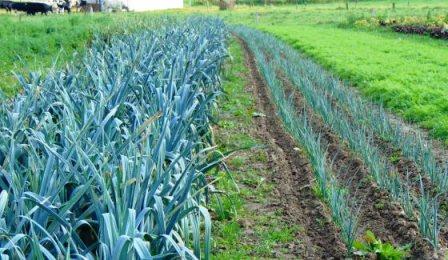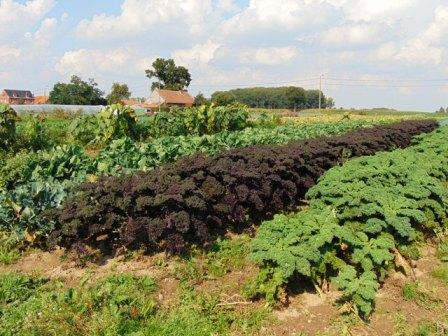 (Winter) leek is a biennial crop. The second year of cultivation, the plant comes to seed formation. Once bolting starts, the quality of the product goes brighlyt backwards. It may therefore remain outside in the winter and can still de harvested. You can place some plants in shed or basement in crates because the ground outside sometimes in the winter is frozen too hard to harvest. Some varieties are naturally suited better for this than others.
(Winter) leek is a biennial crop. The second year of cultivation, the plant comes to seed formation. Once bolting starts, the quality of the product goes brighlyt backwards. It may therefore remain outside in the winter and can still de harvested. You can place some plants in shed or basement in crates because the ground outside sometimes in the winter is frozen too hard to harvest. Some varieties are naturally suited better for this than others.
Also carrots and salsify can overwinter on spot when coved with dry material.
Kale and sprouts may overwinter outside. Sprouts you pick from bottom to top. They taste even better when they have had some frost.
Purple hardy broccoli is sown in early summer, planted in July and given one more hilling in September. At the first soft temperatures the growth resumes.
Corn salad (Valerianella locusta) is not realy hardy but resistant to -9°C and after the frost the grow continues. With a little shelter (clock, foil..) you can get early harvest.
Winter Purslane can still be sow at the end of the summer to pick or cut (in winter) for months from.
Parsnip (Pastinaca sativa subsp. Sativa, also white root) is an umbelliferous (Apiaceae). The 20 to 40 (!) cm long cream - white root has a celery- and sweet aniseed flavor. Due to the length of the taproot deep spaded or loose soil is needed. Parsnip is usually sown in the second half of April or later. The seeds are harvested in August.
 The root can be eaten young, but also as a winter vegetable. The roots begin to thicken from November and can easily stay in the ground until March as they are hardy.
The root can be eaten young, but also as a winter vegetable. The roots begin to thicken from November and can easily stay in the ground until March as they are hardy.
Grub after a cold period, the taste will be even better.
Parsnip was before the introduction of the potato an important staple food.
You can eat it raw or boiled or braised, fried, as stew or fried like potato chips.
I also once made wine of them, but I had to throw it away (as slime). I think that the blame lay with the creator rather than the parsnip.
(Possibly parsnip is fallen into disuse because he was sometimes confused with poisonous hemlock (Chaerophyllum temulum).)
Of large parsnip carrots best remove the hardened middle.
Also Jerusalem artichoke, salsify, winter purslane, winter leek, Hamburg parsley (Petroselinum crispum var. tuberosum) are hardy.
Winter vegetable chicory
This typical white Belgian endive, known in Dutch as witloof or witlof ("white leaf") is hardly know in the U.S. Petroselinum crispum var. tuberosum is a leafy vegetable that is grown as a root vegetable. The latter is important to know for the fertilization and crop monitoring. The cultivation of witloof consists of two stages, namely first the cultivation of the carrot on the field and then growing the tight leaf crop in pits (soil chicory) or cisterns.
Use in the field little or no nitrogen. In not fine crafted soil you get branched roots leading to difficulties in later stacking in. Excavating period: from September to December.
The chicory roots remain after lifting for a minimum of 14 days lying on the field to relax.
Put them in a fan shape on each other so that the leaves always cover the roots. If they are not covered, the roots will burn by the sun.
The foliage from a root of normal size is cut 3cm above the root collar, the cut should be flat. The thicker the root the longer the left crop part should be.
Possibly you cut off the root tip so that the roots are all equaly about 18 centimeters long. Rotten leaves are removed.
Insert a row of chicory roots in a coffin. Sprinkle some ground against it. Then the next row, etc. Until the canal or crate is full. Sprinkle a layer of soil of several centimeters over the roots and rinse with a strong jet of water so that the heads become visible again and are almost free from dirt, and soil is close between the roots.
The roots now have sufficient soil and water. Basically do not water until the end of cultivation. Leave the coffins several hours outside to drain excess water. Make sure there comes no frost and no light at the chicory (dark shed or basement, cover with leaves or soil...). Four weeks after stacking in the crops are ready to be harvested.
You can also eat chicory without bleaching it, as green chicory, and after cutting off you can grow it a second time.
Widow cultivation, that’s how we possibly could translate the grow process op the Flemish early plant technique: weeuwenteelt.
The word means etymological widow (and sometimes also 'plant'). But what link this can have with the growing method of sowing befor the winter and allowing young plants to overwinter to get fresh vegetables in early spring, that remains a mystery.
The weed cultivation was mainly applied around Mechelen. Because it is rather labor-intensive, requires a great deal of care, supervision and manual labor; and working in heated greenhouses has displaced this technique, cauliflowers, lamb's lettuce, winter spinach, celery, kitchen grater, winter purslane, ... are now only cultivated this way by hobby gardeners.
Among others cabbage lettuce, celery, cauliflower and sometimes also head cabbage are sown as winter crops befor the winter, in order to have plant material that has almost grown up before the deep frost of winter. The sowing time depends on the kind of vegetables and seeds, the germination and growth rate, the weather, the desired time of harvest etc. It requires a lot of experience. So in practice you can spread sowing quite a bit, eg twice a week to reduce the risk of loss, and increase the chance of success.
Use varieties that are listed in catalogs as cold resistant.
The widow cultivation of celery is already sown in August. The cultivation of lettuce only starts at the end of October.
During the last two days of September and the beginning of October the first early weed cauliflowers are sown. They overwinter best in stone flowerpots. Later weed crops are sown from ten to twenty October. They can be pricked in large flowerpots in early November.
The sowing season starts earlier when it is overwintered in a dark greenhouse, and later for a light greenhouse.
If it does not freeze, the greenhouse must be ventilated regularly to keep the temperature low and the leaves dry and therefore (false) (mildew) mold-free.
The intention is to grow a sturdy plant. Therefor she must be cool and not too wet, so she keeps growing, very slow!. Do not let the roots grow through and out of the pot.
In the case of frost in the greenhouse, you must temporarily cover the plants.
In good weather conditions and not too wet soil, the plants can sometimes be planted at the end of February, usually at the beginning of March. You can also plant in the greenhouse in early January.
There is also winter cauliflower and winter kale. These are specially selected varieties, such as the "Walcheren winter", which you sow in the summer and which can withstand freezing temperatures. They are grown outside, but in case of severe frost you also have to cover them.
